President Trump’s Bold Military Gamble Against Iran’s Nuclear Program
Introduction: A Historic Military Decision
In January 2020, President Donald Trump made a momentous decision when he ordered a military strike against Iranian General Qassem Soleimani. This action marked a significant deviation from the long-standing U.S. strategy of managing Iran’s nuclear ambitions primarily through sanctions and diplomatic engagements. For years, previous administrations had sought to curb Iran’s nuclear program by leveraging international pressure, negotiations, and treaties, notably the Joint Comprehensive Plan of Action (JCPOA) established in 2015. However, the efficacy of these diplomatic measures had been widely debated, leading to ongoing concerns regarding Iran’s commitment to limiting its nuclear capabilities.
Trump’s decision to strike Iran can be seen through multiple lenses, primarily as a bold military gamble aimed at reshaping U.S.-Iran relations and sending a clear message regarding Iran’s activities in the Middle East. The historical context surrounding the strike is essential to understanding its implications; tensions had been escalating due to Iran’s perceived threats to U.S. interests in the region, including attacks on military personnel and facilities. The strike against Soleimani was not just a tactical move, but also a strategic one, depicting a shift from a policy of containment to one of active engagement.
This marked a pivotal moment in U.S. foreign policy, as it underscored a willingness to use military force as a means of deterrence. The implications of this decision were significant, raising questions about the potential for retaliation from Iran and the subsequent impact on regional stability. As the United States navigates its complicated relationship with Iran, the effectiveness of military strikes against Iranian targets in curtailing its nuclear ambitions remains a focal point of debate among policymakers and analysts alike. Ultimately, President Trump’s military strike has redefined the conversation around America’s approach to Iran and its nuclear future.
The Strategy Behind the Strikes
The decision by President Trump to utilize military force against Iran is rooted in a complex interplay of geopolitical considerations, national security interests, and a longstanding apprehension regarding Iran’s nuclear weapons program. For years, concerns have been mounting over Iran’s potential to develop nuclear capabilities that could threaten regional stability and U.S. interests in the Middle East.
The specific targets chosen for the strikes were not arbitrary; they were strategically significant locations believed to be involved in the development of Iran’s nuclear arsenal. By focusing on such critical sites, the intention was to diminish Iran’s capacity to advance its nuclear ambitions swiftly. The rationale is that military strikes could provide a more immediate and impactful deterrent than other measures that had previously been employed, such as sanctions or covert operations.
For a long time, the U.S. had relied on a combination of sanctions, sabotage, and cyberattacks to curtail Iran’s nuclear activities. These tactics, while occasionally successful, have proven to be insufficient in fully addressing the escalating concern regarding Iran’s unwavering commitment to its nuclear program. Sanctions, although crippling to the Iranian economy, did not stop Iran from pursuing its nuclear aspirations. Similarly, sabotage efforts did result in some disruption, yet evidence suggests that Iran managed to recover its capabilities relatively quickly.
By opting for military action, President Trump signaled a shift in strategy aimed at achieving more decisive results. The strikes aimed not just at punishing Iran for its transgressions but at conveying a clear message that the U.S. remains resolute in preventing the further development of Iranian nuclear weapons. This pivotal military response reflects a recognition that more proactive measures were necessary to mitigate the risks associated with a nuclear-armed Iran and protect U.S. and allied interests in the region.
Potential Consequences: Retaliation and Global Response
The military strikes against Iran’s nuclear program, exemplified by the deployment of U.S. bombs, could lead to significant repercussions both regionally and globally. Iranian officials have historically suggested that any attack would provoke robust retaliation, potentially through cyber warfare, direct military confrontations, or orchestrated proxy attacks against U.S. installations and allies in the Middle East. Such actions would not only escalate tensions but could also disrupt the fragile balance of power in the region.
Furthermore, a response from Iran may galvanize its regional allies, including militant groups and nations sympathetic to its cause. This alliance could potentially lead to coordinated attacks on U.S. interests in an effort to demonstrate solidarity and resistance against perceived American aggression. The role of these proxies is significant, as they could operate in ways that complicate direct engagement for the U.S., yielding a protracted conflict that would be detrimental to regional stability.
The international response is also a critical factor to consider in the aftermath of U.S. military action. Allies and adversaries alike will closely monitor the situation, scrutinizing the United States’ actions and the legitimacy of its justifications for intervention. Global oil markets might be profoundly affected, as increased instability in the region could lead to disruptions in oil supply. Such fluctuations have historically resulted in drastic changes to oil prices, impacting economies worldwide and possibly leading to a renewed call for diplomatic resolutions.
Moreover, this military gamble may redefine U.S. foreign policy, pushing the nation toward a more aggressive posture in the Middle East while simultaneously complicating its relationships with allies who advocate for diplomatic engagement over conflict. It is essential to bear in mind that the consequences of military strikes are complex and multifaceted, requiring careful examination of both short-term and long-term impacts on U.S.-Iran relations and the broader geopolitical landscape.
Conclusion: A Bold Gamble with Uncertain Outcomes
President Trump’s decision to employ military action against Iran’s nuclear program is undoubtedly a bold gamble that carries both significant risks and potential rewards. The initiative aims to disrupt Iran’s ability to develop nuclear weapons, a concern that many nations, including the United States, have been grappling with for years. By using military force, the U.S. hopes to undermine Iran’s capabilities, thereby reducing the threat posed by its ballistic missiles and nuclear ambitions. However, this military intervention is laden with uncertainties that could lead to unintended repercussions.
The primary benefit of such a military approach would be a temporary setback to Iran’s nuclear aspirations. Disrupting the facilities associated with the development of nuclear weapons can delay any advancements Iran might make in this arena. For the Trump administration, demonstrating a firm stance against Iran could serve to reassure regional allies who perceive a nuclear-armed Iran as a direct threat to their national security. Furthermore, effective disruption of Iran’s nuclear program could potentially spark increased diplomatic engagement from other nations in the effort to achieve a long-term resolution regarding nuclear proliferation.
Nevertheless, the risks associated with U.S. bombs against Iran cannot be overlooked. Military interventions often escalate tensions and can lead to retaliatory actions, thereby destabilizing an already volatile region. Such actions may further complicate relationships with traditional allies and adversaries alike. The potential for increased conflict raises critical questions about the future dynamics between the U.S. and Iran, as well as the enduring impact of these military decisions on international diplomatic efforts aimed at curbing nuclear proliferation. The gamble taken by the Trump administration stands to alter the geopolitical landscape significantly, but the fragility of peace in the Middle East remains at stake.








